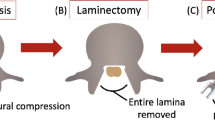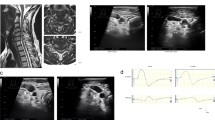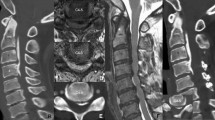Abstract
Study design:
Two patients who experienced the onset of segmental motor paralysis several years after laminoplasty are presented.
Objectives:
To discuss the mechanism of development of delayed segmental motor paralysis following laminoplasty.
Setting:
A department of orthopaedic surgery in Japan.
Methods:
One patient experienced motor weakness in his deltoid and biceps muscles on the left side 5 years after laminoplasty. The other patient noticed motor weakness in his deltoid and biceps on the right side 7 years after laminoplasty. CT myelography revealed posterior spur formation and hypertrophic facet joints on the hinged side at the C4–C5 level in both patients.
Results:
Posterior foraminotomy was performed at the C4–C5 level on the hinged side in both patients. Postoperatively, motor weakness in the deltoid and biceps muscles was improved in both patients.
Conclusions:
Although spondylotic changes, including spur formation and disc herniation, have occasionally developed in operated segments after laminoplasty, few patients have required additional surgery for treatment of relapse of neurological deficits. It has been believed that spinal cord is rarely compressed by the spondylotic changes since it shifts posteriorly in the enlarged spinal canal. However, laminoplasty disturbs the facet joints since the medial portion of dorsal cortex and cancellous bone in facet joints is drilled out to make a trough. Facet joints disturbed in this fashion undergo degeneration over time after surgery. Nerve roots may occasionally be compressed by degenerated facet joints and spurs that have developed at the entrance of root canal, resulting in segmental motor paralysis several years after laminoplasty. Careful long-term observation is necessary after this procedure.
Similar content being viewed by others
Log in or create a free account to read this content
Gain free access to this article, as well as selected content from this journal and more on nature.com
or
References
Kimura I, Oh-hama M, Shingu H . Cervical myelopathy treated by canal-expansive laminoplasty: computed tomographic and myelographic findings. J Bone Joint Surg 1984; 66-A: 914–920.
Itoh T, Tsuji H . Technical improvements and results of laminoplasty for compressive myelopathy in the cervical spine. Spine 1985; 10: 729–736.
Kawai S, Sunago K, Doi K, Saika M, Taguchi T . Cervical laminoplasty (Hattori's method): procedure and follow-up results. Spine 1988; 13: 1245–1250.
Hirabayashi K, Satomi K . Operative procedure and results of expansive open-door laminoplasty. Spine 1988; 13: 870–876.
Hase H et al. Bilateral open laminoplasty using ceramic laminas for cervical myelopathy. Spine 1991; 16: 1269–1276.
Nakano K, Harata S, Suetsuna F, Araki T, Itoh J . Spinous process-splitting laminoplasty using hydroxyapatite spinous process spacer. Spine 1992; 17: S41–S43.
Satomi K, Nishi Y, Kohno T, Hirabayashi K . Long-term follow-up studies of open-door expansive laminoplasty for cervical stenotic myelopathy. Spine 1994; 19: 507–510.
Tomita K, Kawahara N, Toribatake Y, Heller JG . Expansive midline T-saw laminoplasty (modified spinous process-splitting) for the management of cervical myelopathy. Spine 1998; 23: 32–37.
Tanaka J, Seki N, Tokimura F, Doi K, Inoue S . Operative results of canal-expansive laminoplasty for cervical spondylotic myelopathy in elderly patients. Spine 1999; 24: 2308–2312.
Hirabayashi K, Toyama Y, Chiba K . Expansive laminoplasty for myelopathy in ossification of the longitudinal ligament. Clin Orthop 1999; 359: 35–48.
Edwards II CC, Heller JG, Silcox DH . T-saw laminoplasty for the management of cervical spondylotic myelopathy: clinical and radiographic outcome. Spine 2000; 25: 1788–1794.
Seichi A et al. Long-term results of double-door laminoplasty for cervical stenotic myelopathy. Spine 2001; 26: 479–487.
Ciba K, Toyama Y, Watanabe M, Maruiwa H, Matsumoto M, Hirabayashi K . Impact of longitudinal distance of the cervical spine on the results of expansive open-door laminoplasty. Spine 2000; 25: 2893–2898.
White AA, Johnson RM, Panjabi MM, Southwick WO . Biomechanical analysis of clinical stability in the cervical spine. Clin Orthop 1975; 105: 85–96.
Tsuzuki N, Abe R, Saiki K, Zhongshi L . Extradural tethering effect as one mechanism of radiculopathy complicating posterior decompression of the cervical spinal cord. Spine 1996; 21: 203–211.
Yonenobu K, Hosono N, Iwasaki M, Asano M, Ono K . Neurologic Complications of surgery for cervical compression myelopathy. Spine 1991; 16: 1277–1282.
Yonenobu K, Hosono N, Iwasaki M, Asano M, Ono K . Laminoplasty versus subtotal corpectomy: a comparative study of results in multisegmental cervical spondylotic myelopathy. Spine 1992; 17: 1281–1284.
Iwasaki M, Ebara S, Miyamoto S, Wada E, Yonenobu K . Expansive laminoplasty for cervical radiculopathy due to soft disc herniation. A comparative study of laminoplasty and anterior arthrodesis. Spine 1996; 21: 32–38.
Uematsu Y, Tokuhashi Y, Matsuzaki H . Radiculopathy after laminoplasty of the cervical spine. Spine 1998; 23: 2057–2062.
Yone K, Matsunaga S . Posterior procedures for myelopathy: indications, techniques, and results. Semin Spine Surg 1999; 11: 331–336.
Wada E, Suzuki S, Kanazawa A, Matsuoka T, Miyamoto S, Yonenobu K . Subtotal corpectomy versus laminoplasty for multilevel cervical spondylotic myelopathy: A long-term follow-up study over 10 years. Spine 2001; 26: 1443–1448.
Chiba K, Toyama Y, Matsumoto M, Maruiwa H, Watanabe M, Hirabayashi K . Segmental motor paralysis after expansive open-door laminoplasty. Spine 2002; 27: 2108–2115.
Edwards II CC, Heller JG, Murakami H . Corpectomy versus laminoplasty for multilevel cervical myelopathy: an independent matched-cohort analysis. Spine 2002; 27: 1168–1175.
Author information
Authors and Affiliations
Rights and permissions
About this article
Cite this article
Yone, K., Hayashi, K., Ijiri, K. et al. Delayed segmental motor paralysis following laminoplasty: two case reports. Spinal Cord 44, 461–464 (2006). https://doi.org/10.1038/sj.sc.3101866
Published:
Issue date:
DOI: https://doi.org/10.1038/sj.sc.3101866



